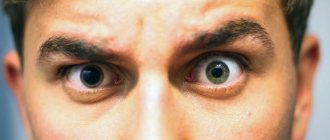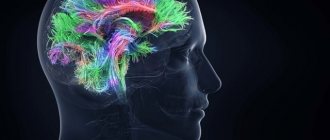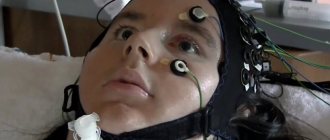Competition “Bio/Mol/Text”-2020/2021
This work was published in the “Free Topic” category of the “Bio/Mol/Text” competition 2020/2021.
The general partner of the competition is the annual biotechnology conference BiotechClub, organized by the international innovative biotechnology company BIOCAD.
The sponsor of the competition is SkyGen: a leading distributor of life science products on the Russian market.
Competition sponsor: the largest supplier of equipment, reagents and consumables for biological research and production.
"Book" sponsor of the competition - "Alpina Non-Fiction"
Autism spectrum disorders (ASD) are developmental disorders that are characterized by deficits in social interaction, dysfunction of sensory systems, and a tendency to engage in stereotypic behavior. Some people with ASD also have underlying autoimmune disorders and picky eating.
A little about terminology
The World Health Organization (WHO) notes that autism spectrum disorder in the modern sense is an umbrella term that "encompasses conditions such as autism and Asperger's syndrome." The US Centers for Disease Control and Prevention (CDC) also classifies pervasive developmental disorder not otherwise specified (PPD-NOS) as ASD. In the International Classification of Diseases, Tenth Revision (ICD-10), there is no diagnosis of “autism spectrum disorder”, and diagnostic subcategories such as childhood autism, atypical autism, Asperger’s syndrome belong to category F84 “General disorders of psychological development”. ICD-10 will be valid until January 1, 2022. After this, ICD-11 comes into force. In the International Classification of Diseases, 11th revision, the diagnosis of “autism spectrum disorder” appears, but the categories “autism” and “Asperger syndrome” disappear. According to ICD-11, ASD will be subcategorized based on the presence/absence of an intellectual disorder and the person's ability/inability to use spoken or written language. And those cases that are difficult to classify according to these characteristics will fall into the subcategories of “Other autism spectrum disorder, specified” and “Autism spectrum disorder, unspecified.” As we see, not only in the field of diagnosis, but also in the field of ASD terminology there is no clarity and unambiguity.
According to the World Health Organization, the incidence of ASD in the world is 1:160. However, the WHO notes that this “estimate is an average figure, and reported prevalence varies significantly between studies.”
According to the US Centers for Disease Control and Prevention, autism spectrum disorder occurs in one in fifty-four children, or 18.5 people per 1,000. The CDC conducted research on eight-year-old children living in 11 states in America and the incidence of autism spectrum disorder varies from 13.1 to 31.4 per 1000 people [1].
Based on such serious differences in figures between WHO and CDC data, we can conclude that diagnosing ASD is a problematic area.
Reasons for the difficulty of diagnosing ASD
Controversial issues in diagnosing autism spectrum disorders boil down to several main aspects:
- lack of a unified diagnostic method;
- diversity of approaches to understanding the essence of autism spectrum disorders;
- ambiguity in the interpretation of the terms “autism” and “ASD”;
- vagueness of diagnostic criteria.
All this leads, on the one hand, to a significant number of people with undiagnosed autism spectrum disorders, and on the other hand, to overdiagnosis of ASD in some regions.
Meanwhile, it is diagnostics that makes it possible to provide timely assistance, improve the quality of life, and enables the patient and his family to understand the reasons for unwanted behavior and take appropriate measures.
Diagnostics
Identifying Asperger's syndrome is actually not an easy task. To do this, specialists from different fields are involved - psychologists, psychiatrists, neurologists, geneticists. Various studies are needed because the manifestations of the syndrome are similar to the symptoms of other disorders.
Diagnostics of children
It is important to detect symptoms in children as early as possible because this makes treatment easier. To make a diagnosis, conversations are held with the child, including tests and games.
In addition, the specialist talks with the child’s parents to obtain information about his behavior in the family, at school, and during everyday activities. A conversation with parents will help identify manifestations of the syndrome in them.
Diagnosis of adults
Asperger syndrome is more difficult to identify in adults because symptoms of the disease change with age. However, there are a number of methods to diagnose the disorder in adults. These include, in particular, standard tests:
- 1.Test. Based on an analysis of the patient's perspective. The test is often carried out using a photo. As already mentioned, the gaze of a person suffering from the syndrome expresses nothing and is directed to nowhere.
- 2.Test. Determines the degree of empathy - the emotional development of the subject. Aspergers have lower scores on this test than healthy people.
- 3.Test. Shows the presence of ritual behavior, “obsession”.
Diagnosis of ASD
Today, autism spectrum disorders are diagnosed using standardized tests.
The main methods are presented in Table 1. Table 1. Methods for diagnosing ASD
| Test name | Abbreviation | Brief description of the test |
| Childhood Autism Rating Scale | CARS | The scale is designed for children 2–4 years old and is suitable for primary screening of ASD symptoms. The technique is a screening method and cannot serve as a basis for diagnosis. |
| Modified Checklist for Autism in Toddlers, Revised | M-CHAT-R | The test is designed for parents. Allows you to identify the risk of developing ASD in a child. The test cannot serve as a basis for making a diagnosis. An additional assessment of the child by a specialized specialist is necessary. Designed for ages 18–30 months. |
| Autism Treatment Evaluation Checklist | ATEC | The test serves to assess the dynamics of a child’s development and the effectiveness of rehabilitation methods. A diagnosis cannot be made based on the test results. To make a diagnosis, you should consult a specialist. |
| Checklist for Autism Spectrum Disorder | CASD | A fast and relatively reliable method for diagnosing ASD. Designed for children from 1 to 16 years old. The test consists of 79 questions that must be answered “Yes” or “No”. |
| Autism Diagnostic Observation Schedule | ADOS | Testing is carried out by a psychiatrist or certified specialist. There are variations of the test for different age groups, including adults. |
| Autism Diagnostic Interview–Revised | ADI-R | Parent questionnaire, ADOS supplement. |
| Additional tests | ||
| Verbal Behavior Milestones Assessment and Placement Program | VB-MAPP | The verbal assessment and milestone program is not directly related to the diagnosis of ASD. But it allows you to track the dynamics of language and social skills, which is very important when building a correction program. |
| Wechsler test | — | It is not directly related to the diagnosis of ASD, but it allows us to understand the level of intellectual development, which is important for the construction of correctional classes. There are three versions of the Wechsler scale, depending on the age of the test taker. |
The essence of these methods comes down to the following: a parent, psychotherapist, neurologist or psychiatrist evaluates a person on an existing scale. The assessment is based on observations and interviews with the person being tested or his relatives. It is clear that with this approach, estimates for the same person given by different people can differ greatly. Temple Grandin, who was one of the first to openly talk about her life with ASD, writes in the book “Opening the Doors of Hope” that she was not diagnosed with autism for a long time only because she had speech [2]. This aspect significantly influenced the score on the test, and as a result, the specialist came to the conclusion that Temple Grandin does not have ASD. The correct diagnosis was made to her later.
Modern creators of diagnostic tests claim that the probability of identifying people with autism spectrum disorders is very high. For example, the developers of the CASD methodology report that their questionnaire is able to identify children with autism with 99.5% accuracy. CASD data have 93–98% agreement with established autism diagnostic tools and 90% agreement between clinicians and parents. However, such optimistic figures do not negate the need to search for relatively objective markers of ASD and reliable differential diagnosis of other developmental disorders.
Markers of autism spectrum disorders can be looked for at different levels of functioning of the body. Thus, some researchers look for them in the neuroanatomical differences between individuals with ASD and normotypical people. These features may come down to insufficient boundaries between the gray and white matter of the brain, thickening of the cortex, increased neuron density, specificity of the cerebellum and signal transmission, and reduced size of amygdala neurons in people with ASD [3]. A little more detail about the supposed neuroanatomical differences in people with ASD can be found in the article “Autism Spectrum Disorder: “Children of the Rain”” [4].
There are studies that link ASD to three phases of pathological changes in brain volume (Fig. 1). Based on these findings, children with autism spectrum disorder exhibit abnormal brain overgrowth between the ages of 2 and 4 years. Since this increase occurs during the first detectable behavioral signs of ASD, it is conceivable that the neural defects causing the increase may underlie autism spectrum disorders. This is followed by a growth arrest phase. At the age of 12–16 years, a decrease in brain volume is possible, as well as partial atrophy of the cerebral cortex and amygdala [5].
Figure 1. Three phases of pathological changes in brain volume in ASD.
[5]
There are also suggestions about immune and autoimmune differences in people with ASD. Thus, individuals with autism spectrum disorders may experience a general suppression of cellular immunity, decreased killer cell activity, and subnormal levels of certain types of lymphocytes. Some authors hypothesize the autoimmune nature of autistic regression. ASD may also be caused by chronic neuroinflammation in the mother, which has “impacts on neuronal maturation, function and apoptosis” [3].
Some studies cite dysfunction of mirror neurons, which are responsible for imitation and empathy, as the cause of ASD [6]. Another possible pathway for the development of autism spectrum disorders is mitochondrial dysfunction, which leads to dysregulation of calcium channels [3].
These differences form the basis of theories that try to explain the development of ASD. Among them:
- theory of redundancy of short neural connections and insufficiency of long ones;
- mirror neuron theory;
- neural migration theory;
- theory of imbalance of excitation-inhibition processes;
- theory of dendrite morphology;
- neuroimmune theory;
- neuroinflammation theory;
- theory of mitochondrial dysfunction [3].
This article is devoted to an attempt to search for genetic markers for diagnosing autism spectrum disorders.
Causes of the disease
Unlike Down syndrome, which is characterized by a gene mutation that manifests itself in the form of an extra chromosome, such abnormalities are not detected in Asperger's disease. Perhaps this is also related to differences in symptoms, although the high intellectual level of patients unites these conditions. The exact etiology of this form of autistic disorder is currently unknown. It is assumed that autoimmune processes occurring in the child’s body while in the uterus, which lead to damage to brain structures, are involved in the pathogenesis. Risk factors for developing the disease include genetic predisposition, postnatal infections, and fetal intoxication during pregnancy.
ASD and genetics
The issue of genetic causes of ASD has long been discussed. This theory is supported by the fact that in one family two or more children can be on the autism spectrum. Indirect evidence that ASD is genetic in nature is the fact that this developmental disorder occurs four times more often in boys than in girls. If it were possible to accurately describe the genetic basis of autism, this would help in diagnosis and become the basis for the correction of ASD.
One of the largest studies in this area was carried out in 2019–2020 by a team from the Mount Sinai Hospital Medical School (USA). Based on the results of this study, a list of one hundred and two genes associated with autism was compiled [7]. The results of the study are presented in more detail in Figure 2. The higher a gene is located in the figure, the greater the likelihood that its mutation will cause ASD.
Figure 2 Results of a study of genes associated with ASD.
[7]
The team focused on the exome, the part of the genetic material that is transcribed into messenger RNA. Almost 12,000 children with autism and about 20,000 normal people took part in the experiment. Such large-scale studies are an important step towards the diagnosis and correction of autism [7]. Let's look at some genes supposedly involved in the formation of autism spectrum disorders.
NRXN genes
The NRXN family consists of three genes: NRXN1, NRXN2 and NRXN3.
These genes encode neurexins (NRXN), adhesion proteins that are located on the presynaptic membrane and bind to their postsynaptic counterparts, neuroligins. A low number of copies of the NRXN genes or point mutations in them can cause the development of ASD [8].
NLGN genes
The NLGN family consists of five genes that encode neuroligins. ASD may be caused by deletions or frameshift mutations in the NLGN4 gene. As a result, the synthesized protein is shorter than necessary to fully perform its functions. There are also cases of point mutations in the NLGN3 gene, which presumably lead to the appearance of ASD [9]. A possible mechanism of influence is as follows: mutations in the NLGN3 gene cause disruption of oxytocin signaling, which leads to specific behavioral strategies that are characteristic of people with autism spectrum disorders. Experiments in mice have shown that such mutations can be corrected using a highly specific kinase inhibitor. The inhibitor helps restore oxytocin signaling pathways and partially normalizes behavioral reactions [9].
SHANK genes
The SHANK1, SHANK2, SHANK3 genes encode phosphoproteins of the same name. All of them are ASD-associated, but the SHANK3 gene has the greatest diagnostic significance. It encodes a protein that is essential for the formation of neural connections. With a lack of SHANK3 protein, the function of NMDA receptors (n-methyl, D-aspartate), which play an important role in the regulation of higher nervous activity, is impaired [8]. SHANK3 deficiency impairs the induction and maintenance of dendritic spines [3].
Statistics show that approximately 1% of ASD cases are associated with the SHANK3 gene. Studies of the effect of defects in this gene on behavioral reactions were carried out on mice. When a working copy of the SHANK3 gene was turned on, adult mice showed an increase in social contacts, but the level of anxiety continued to remain high [10].
CDH and PCDH genes
The CDH gene family encodes cadherins. The latter are glycosylated transmembrane proteins that influence intercellular adhesion, neuronal migration, synapse formation and synaptic remodeling. Since the functioning of cadherins is influenced by the presence of Ca2+, they are called calcium-dependent cell adhesion molecules. There are classical cadherins (CDH), desmosomal cadherins (DSC) and protocadherins (PCDH).
The family of these genes is quite extensive. Mutations in the following genes are associated with ASD: PCDH9, PCHD13, CDH13, CDH10, CDH9, CDH8. The latter has the greatest diagnostic value [8]. Research has shown that transgenic mice with a 30% reduction in the amount of CH8 protein exhibited repetitive behavior and signs of anxiety. In addition, the development of the nervous system of mice was delayed. It is assumed that this is due to an increase in the level of the REST protein, which is capable of suppressing the expression of many genes responsible for the development of the nervous system [11].
ENGRAILED genes
This gene family is involved in the development of the hindbrain and midbrain. The ENGRAILED-2 (EN2) gene is of particular diagnostic importance, as it has a significant impact on the development of the cerebellum [3]. Mice with a defective EN2 gene have motor impairments, establish social connections worse, and have reduced memory. The size of the cerebellum of such mice is smaller than that of their normotypical counterparts [12].
* * *
The genes described above are only a small part of those that may be associated with autism spectrum disorders. Given the amount of research on ASD, this list will grow in the coming years.
It is also interesting to study the mutual influence of the identified genes on each other. These influences can be the most unpredictable. For example, the miR-873 gene, associated with autism, regulates the expression of the ARID1B, SHANK3 and NRXN2 genes, which, in turn, have an active effect on the development of the nervous system [13].
One hundred and two genes with their complex interactions are enough to provide work for a large number of researchers. But the situation becomes even more complicated if you read the publication of Jian Zhou and his colleagues, who state that the formation of autism can be influenced not only by exons, but also by introns of the genome [14]. This turn forces us to look at the problem of diagnosing ASD from an unexpected angle and poses new challenges for researchers.
It is important to note that despite the considerable attention that researchers have devoted to studying the genetic markers of ASD, there is no clear direct link between autism spectrum disorders and a specific mutation. Today we can only say that there are genes that increase the risk of autism spectrum disorders.
Molecular markers of ASD
To diagnose ASD, they are trying to find not only genetic markers, but also molecular ones. Thus, scientists from the University of Warwick have established a connection between autism spectrum disorders and the following parameters: increased levels of advanced glycation end products and dityrosine in the blood plasma, reduced renal clearance of arginine [15].
There is also a possibility that in the future serotonin, oxytocin, and gamma-aminobutyric acid will be used as biomarkers of ASD [16], [17]. However, all these studies have not yet been completed, and none of these substances can yet be considered a universal molecular marker of ASD.
Diagnostic testing
Asperger's syndrome must be distinguished from the group of neurological and psychiatric disorders. This is of great importance both in treatment and prognosis. This disease often accompanies diseases such as schizophrenia, so it is important for the patient to undergo a thorough diagnosis to rule out other health problems.
There is a specific test for autism in adults and children, on the basis of which a questionnaire was created to identify Asperger's disease. The doctor deciphers the results, since the information received can only be interpreted correctly in combination with the clinical manifestations of the pathology. There are about five different testing methods that psychiatrists use to identify autistic disorders in children and adults. Although the severity of the testing questions depends on the age of the patients, they are all aimed at determining the test subject’s level of intelligence, characterizing his sensory sensitivity, as well as assessing imagination and creative potential. For these purposes, doctors in tests for Asperger's syndrome use both communication and various pictures and photos, as well as tasks with decoding metaphors.
Already during the initial examination, doctors pay attention to the specific behavior of patients. Such characteristics are much more pronounced in adults, since children, even in the absence of psychiatric disorders, are prone to rejecting strangers. People behave strangely at appointments; often they are not even able to immediately detect the doctor in the office. Patients wander around the room, their movements awkward. Asperger's syndrome also leaves its mark on a person's facial expressions and his speech, which becomes monotonous. Moreover, patients are often highly educated and intelligent individuals who tend to detail their narrative, sometimes even excessively. When testing, much attention is paid to the emotional response to greetings, smiles or jokes. Patients with Asperger's syndrome do not have a sense of humor and do not reciprocate signs of affection.
In the modern world, people with autistic disorders have more social contacts than 20 years ago, due to the development of the Internet. Many patients have virtually no real friends and acquaintances, but communicate with people on the Internet. This greatly facilitates further adaptation and restoration of communication abilities. Difficulties arise precisely when establishing personal contacts, which is revealed during testing.
Differential diagnosis of ASD
The difficulty in diagnosing autism spectrum disorders arises when trying to differentiate them from other pathologies and developmental disorders. Here there is terminological confusion and the lack of a unified approach to understanding the nature of ASD. For a long time, in the post-Soviet space, the diagnosis of “autism” was given only to children. After 18 years, it was replaced by either a diagnosis of “schizophrenia” or a diagnosis of “mental retardation” (with reduced intelligence). Now there is an active revision of such approaches to diagnosis. However, a significant part of domestic specialists still believe that the nature of ASD and schizophrenia is related and they are simply different poles of the same condition [3]. In contrast, many foreign experts believe that these disorders are fundamentally different conditions, and they never transform into each other. This view is typical of the American diagnostic school. Within the framework of this concept, schizophrenia should be accompanied by hallucinations and delusions, which is not typical for autism spectrum disorders [3].
Similar questions sometimes arise in the differential diagnosis of ASD and ADHD (attention deficit hyperactivity disorder).
Theoretically, studying the genetics of these developmental disorders could clarify their diagnosis. But the data available today only confuses the situation. For example, the SHANK3 gene, associated with autism, is also used to diagnose schizophrenia [18], [19]. Deletions in the NRXN1 gene can be associated not only with autism spectrum disorders, but also with pathologies such as schizophrenia, bipolar disorder, ADHD, and Tourette syndrome [8].
To summarize, we can say that autism spectrum disorders are multifactorial in nature. However, genetic markers for diagnosing ASD may in the future become an important basis for early diagnosis and timely correction of this developmental disorder.
Treatment and prognosis
Since the exact cause of this mental disorder is currently unknown, the fight against pathology is aimed at controlling symptoms and improving the quality of life of patients and their loved ones. It is important not to self-medicate, but to strictly follow the recommendations of the doctor who performed the diagnosis. This is due to the individual characteristics of each patient, which must be taken into account when selecting therapy. Treatment for Asperger's syndrome in children and adults differs, but is mainly aimed at restoring and developing social skills. Since one of the distinctive symptoms of the disease is coordination disorders, the use of a special set of exercises also shows good results. This promotes the development of fine motor skills and greater confidence in one's own skills.
The need for medication support for patients with Asperger's disease is determined by the doctor. Drug therapy is aimed at relieving symptoms and is associated with the occurrence of severe complications and delayed consequences. The drugs reduce the clinical manifestations of Asperger's syndrome, such as increased anxiety, irritability and sleep disturbances. Risperidone and Fluoxetine are often used.
The prognosis of the disease depends both on the individual characteristics of the patient and on the creation of an environment around him favorable for recovery. This task falls on the patient's closest relatives.
Types of Adults with Asperger's Syndrome
All patients suffering from Asperger's syndrome can be divided into three groups, each of which is characterized by behavioral characteristics and treatment regimens:
- Actor. An individual belonging to this type wants to have relationships with other people. In an effort to achieve a desired goal, they study the social skills of healthy people and simply copy them. Those around them practically do not notice deviations in their behavior, since the “actors” adapt to life quite well.
- Outcast. This group includes adults with Asperger syndrome who strive for interpersonal relationships but have difficulty making friends and maintaining friendships. This is due to a lack of social skills. The “outcasts” really want to adapt to life, but they can’t. Since patients often behave incorrectly and somewhat eccentrically, those around them avoid building any relationships with them. Among people of this type, depression is most common; they themselves seek help in solving their problems.
- Single. This group includes patients who do not want to have interpersonal relationships. Exceptions include very close people who do not pose a danger to the patient. “Loners” almost always choose only one type of solitary activity. They are not interested in the sexual side of life, they very rarely start families, and are emotionally cold and detached. Such people do not completely avoid communication; rather, they can build relationships with other people on an intellectual or professional basis, while avoiding emotional intimacy. “Singles” very rarely seek specialized medical help themselves, since their lifestyle does not cause much suffering. If this happens, then psychotherapy plays a leading role in treatment. Doctors' efforts will be aimed at improving interaction and communication skills, as well as developing and strengthening self-esteem.
Regardless of the specific manifestations of Asperger syndrome, all people suffering from it experience difficulties in everyday life. Quite often, this type of disorder is accompanied by depression, leading to suicidal thoughts. Statistically, the risk of suicide among adults with Asperger's syndrome is much higher than among those with other types of mental disorders. The key risk factor is depression.
Asperger's syndrome in women
Statistics show that Asperger's syndrome and other autism spectrum disorders are more common in boys. However, girls can also have autism or one of its variants.
Relatively recently, a study was conducted in Scotland (Rutherford et al, 2016), the results of which were very interesting. It turns out that among young children with Asperger's syndrome the ratio of boys to girls is 5.5:1, for teenagers the ratio is 2.3:1, and for adults it is 1.8:1. Based on this, we can conclude that this pathology does not occur less frequently in women, it is simply diagnosed later. While boys are brought to doctors by their parents, girls turn to specialists on their own when they become adults.
This state of affairs is partly due to the fact that some symptoms in girls occur differently than in boys. Parents should be wary of their daughter's behavior:
subtle behavioral problems. They are not, according to parents and teachers, something destructive
Therefore, they are often not taken into account. Well, is it really worth taking a girl to a psychiatrist if she doesn’t want to communicate with her classmates? But if a child is too withdrawn and shy, and is constantly alone, then you should think about it and take a closer look at him; selective mutism
This symptom means that the girl cannot speak in some situations, and she cannot choose when exactly she can speak and when not. That is, this week she will be able to answer in school, but next week she will not. It is impossible to predict the incidence of mutism; communicates mainly with boys. Such girls are usually called “tomboys”. Girls with ASD do not share their peers’ passion for fashionable clothes and hairstyles; they simply do not understand why this is necessary. The moment of puberty can come as a shock for them; they are completely devoid of sexuality and do not experience sexual desire. Young women on the autism spectrum may want to have children, but they find adoption more acceptable than having their own due to their reluctance to be intimate with a man; being in a fantasy world. Children tend to immerse themselves in made-up stories and become captivated by fairy-tale characters. As you grow older, such passion recedes, and more real things come to the fore. However, girls with Asperger's syndrome continue to live in fantasy worlds. Psychotherapists explain this by saying that in reality people with ASD feel out of place, but in a fictional world they are loved for who they are.
Asperger syndrome cannot be cured, but identifying it and understanding the characteristics of a person with this pathology allows you to build normal relationships in the family. This applies to both parents with children and spouses. Quite often, women with ASD refuse intimate intimacy, although they sincerely love their spouse. Impaired sensory perception leads to the fact that touching the body (especially in sensitive areas) is perceived as unpleasant or painful. The desire to live according to a routine can turn intimacy into a clearly planned ritual, which a neurotypical partner will quickly get bored with. Understanding what Asperger's syndrome is will help save the family.
Girls with this pathology feel unhappy; they often want to have a loved one and a family, but it is extremely difficult for them to build relationships with the opposite sex. In addition to problems associated with ASD, girls and young women experience depression, gender dysphoria, anorexia nervosa and anxiety disorders due to emotional distress. All this, as well as the desire to understand themselves and the causes of their problems, brings them to the psychotherapist’s office. And only after receiving information about Asperger's syndrome do they accept themselves and learn to live with their innate “peculiarities.” There is no need to fear that you will be misunderstood or forever labeled as “abnormal.” Awareness of the problem is the first step towards improving your own life.








